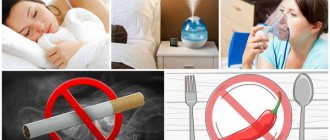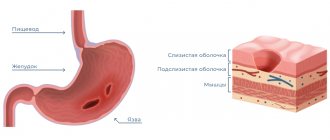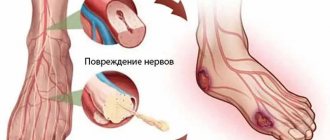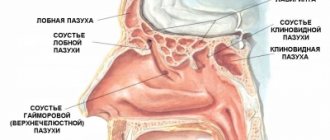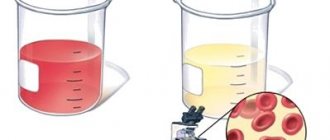Types of bronchiolitis in children
Depending on the duration of symptoms, pathology is divided into two main types:
- Acute – bronchiolitis, which lasts in children for 7-10 days. Coughing and wheezing may persist for up to 2-4 weeks. As a rule, it passes without consequences for the baby’s health Source: Delyagin V.M. Acute bronchiolitis in children Medical Council No. 1 2013, pp. 64-68.
- Chronic - bronchiolitis, which appears in children as a result of complications of the acute form of the disease. Characterized by the persistence of symptoms for 3-4 months a year with periodic remissions and exacerbations.
Treatment for bronchitis
Uncomplicated acute bronchitis does not require hospital treatment. The patient is prescribed:
- bed or semi-bed rest;
- plenty of warm drinks (herbal tea, alkaline water);
- dairy-vegetable diet;
- to give up smoking;
- maintaining high humidity in the room.
Your doctor may recommend antiviral medications, antibiotics for bacterial infections, and phlegm thinners to make coughing easier. For a dry, debilitating cough, drugs that suppress the cough reflex are used. Physiotherapeutic methods are also used: vibration massage, therapeutic and breathing exercises, inhalations, UHF, electrophoresis.
Symptoms
Often the pathology begins as a classic cold. The baby develops a runny nose, a slight rise in temperature, and a slight cough. However, if certain signs are present, the acute stage of bronchiolitis in children can be suspected within a few days. Distinctive symptoms include:
- Dyspnea. One of the main symptoms of bronchiolitis in young children. At first it occurs only when the baby is active, and after some time it persists even at rest.
- Increased breathing rate. Due to difficulty breathing, the baby begins to characteristically inflate the wings of the nose with each breath. At the same time, breathing is superficial and shallow.
- Worsening cough, appearance of wheezing, characteristic hissing and whistling when exhaling. The cough is predominantly dry and does not bring relief.
- Blue skin. Occurs very rarely. Caused by a lack of oxygen in the body.
- Ear infection. In rare cases, in children the disease is accompanied by ear pathologies.
- Dehydration. Manifests itself in the form of dry skin and oral mucosa.
It is important to consider that in children under one year of age, bronchiolitis may not cause pronounced symptoms. The child is conscious, eats normally, and plays in a good mood. At the same time, his breathing only slightly accelerates and shortness of breath appears. If the disease occurs in a more severe form, the baby becomes nervous and capricious.
Symptoms of bronchitis
The main symptom of bronchitis is cough. It is dry at first, worsens at night, and sputum is difficult to separate. Then (after 2-5 days) the cough becomes wet and sputum comes out profusely. The greenish color of the sputum indicates its purulent nature.
In acute bronchitis, along with a cough, there are general signs of infection:
- general malaise, headache, weakness;
- sweating;
- soreness of the muscles of the back and limbs;
- chills, high body temperature;
- runny nose, hoarseness, sore throat.
Chest pain occurs with frequent coughing attacks. Acute bronchitis usually lasts 2-3 weeks; if it lasts longer, it is necessary to exclude the development of a complication - pneumonia (bronchopneumonia).
With chronic bronchitis, inflammation in the bronchi periodically worsens and subsides. Exacerbation usually occurs in cold and damp seasons. The main symptom is increased fatigue and cough for more than 2 years in a row for several months. As a rule, a wet cough bothers you in the morning; a small amount of sputum is coughed up.
The general condition without exacerbation is normal. If chronic bronchitis progresses, then persistent coughing attacks and shortness of breath occur with little physical exertion. It is possible that bronchospasm may occur and asthma may develop.
Causes of the disease
Pathology is quite often diagnosed in infants. Before the first year, about 10-11% of infants suffer from it. Doctors list the main reasons for the development of the disease:
- infection with respiratory syncytial virus, rhinovirus, adenovirus;
- entry into the body of respiratory, fungal and other infections.
As soon as any of the listed viruses or infections enters the body, pathological processes begin to develop. The airways become inflamed, the bronchioles narrow, as a result of which air circulation becomes significantly more difficult. Source: Sukhorukova D.N., Kuznetsova T.A. Epidemiology of acute bronchitis and bronchiolitis in children Eurasian Union of Scientists, 2021.
Experts say that the infection more often enters the body of those infants whose mothers smoke or smoked during pregnancy. In these children, the disease is also more severe. At the same time, breastfed children are less likely to be at risk. Often the virus only causes a cold in them, which does not develop into more complex diseases.
Manifestations of the disease
The most important clinical indicators of bronchiolitis obliterans include the following:
1. Increasing shortness of breath is the main symptom of the disease. At first it creates discomfort, mostly after physical activity. But then it intensifies very quickly and does not stop.
2. Cough in which phlegm does not come out.
3. While listening to the lungs at the beginning of the disease, dry whistling rales are heard, in some cases a characteristic squeak appears on inspiration, often at the bottom of the lungs. But as bronchiolitis develops, vesicular breathing weakens and dry wheezing stops.
4. Pathological changes appear in large bronchi. Colonies of bacterial flora (most often Pseudomonas aeruginosa), mycotic flora (Aspergillus fumigatus) may appear there. In this case, a significant increase in body temperature, cough with sputum, and bronchiectasis are formed.
5. In the late phase of the disease, diffuse warm cyanosis and “panting” when breathing progresses.
The initial stage of bronchiolitis obliterans can occur acutely (if you inhale toxic substances or as a result of viral infections), be delayed and develop gradually, almost imperceptibly - in the case of systemic immunoinflammatory damage to the connective tissue or as a complication of a lung transplant.
Diagnostics
In most cases, a physical examination and listening to the lungs with a stethoscope is enough for the doctor to make a diagnosis. Acute bronchiolitis in children has fairly pronounced symptoms, so its diagnosis is not difficult and does not require additional tests.
However, in some cases, the disease is difficult to distinguish from a common cold. If the symptoms do not allow an accurate diagnosis to be made, or if the symptoms increase rapidly, the doctor will prescribe an additional examination, which includes:
- Blood tests . They provide information about the development of inflammatory processes in the body and oxygen levels.
- Pulse oximetry . Measuring blood oxygen levels. It is carried out using a special sensor that is attached to the finger. A painless, non-invasive method allows you to instantly obtain information about the oxygen saturation of the body.
- Chest X-ray . The examination allows you to distinguish pathology from pneumonia.
- Laboratory test for the detection of respiratory syncytial virus . This is done using a nasal swab. Mainly prescribed in severe cases of the disease. Source: Sukhorukova D.N., Kuznetsova T.A. Treatment of acute bronchiolitis in children in a pediatric setting Russian Pediatric Journal 20(6) 2021, pp. 329-333.
Causes of bronchitis
Acute infectious bronchitis most often occurs in children; its cause is viruses (influenza, parainfluenza, measles, respiratory syncytial virus, etc.). Less commonly, the causative agent of infection is bacteria (staphylococcus, pneumococcus, streptococcus, etc.), they are usually associated with a viral infection.
Non-infectious bronchitis occurs more often in adults; it develops against the background of:
- inhalation of smoke, dust, toxic gases;
- exposure to hot steam or very cold air;
- living in unfavorable climatic conditions;
- allergic reactions.
The cause of chronic bronchitis is most often the combined effect of infections, non-infectious factors and a weakening of the body's defenses.
Very often, chronic inflammation of the bronchi occurs after acute:
- in smokers;
- in persons who abuse alcohol;
- for those working in hazardous industries: in the mining industry, in contact with dust containing cadmium and silicon, miners, builders in contact with cement, workers in the metallurgical and pulp and paper industries, railway workers, workers involved in grain and cotton processing;
- in patients with concomitant diseases (for example, heart disease, chronic nasopharyngeal infections).
Treatment of bronchiolitis in children
Most children, once diagnosed and a treatment plan developed, recover within a few days at home. Treatment of acute bronchiolitis in children at home includes:
- Taking bronchodilators. The dosage regimen and dosage are prescribed by the doctor.
- Using saline drops. If necessary, it is recommended to remove nasal mucus from the baby using an aspirator.
- Drink plenty of fluids.
- Indoor air humidificationSource: Baranov A.A., Namazova-Baranova L.S., Tatochenko V.K., Davydova I.V., Bakradze M.D., Kulichenko T.V., Vishneva I.V., Selimzyanova L.R., Polyakova A.S., Artyomova I.V. Modern approaches to the management of children with acute bronchiolitis. Pediatric Pharmacology, 2021, pp. 339-348.
However, if a child has difficulty breathing, bluish skin, dehydration and other complications, his hospitalization is required. A child can be placed in a hospital earlier if he has diseases of the lungs, heart, or immune system, since the risk of developing a severe form of the pathology is much higher.
Inpatient treatment includes:
- 24-hour monitoring of blood oxygen levels and timely oxygen therapy through a face mask, oxygen tent, and ventilator.
- Control of body hydration. If the baby does not drink enough fluid, it is administered intravenously.
- Taking bronchodilators, corticosteroids.
- Taking medications to reduce and alleviate the symptoms of the disease Source: Sukhorukova D.N., Kuznetsova T.A. Treatment of acute bronchiolitis in children in a pediatric setting Russian Pediatric Journal 20(6) 2021, pp. 329-333.
Acute bronchiolitis against the background of exacerbation of chronic bronchitis. Clinical case
All recommendations were followed in full, but against the backdrop of smog in Moscow, the patient’s well-being worsened. On August 12, shortness of breath and weakness intensified, a short-term cessation of breathing occurred with loss of consciousness and a drop in blood pressure to 60/30. Resuscitated by her daughter. An ambulance team was called; there were no signs of acute coronary syndrome on the ECG. The patient was offered hospitalization in a hospital, which she refused. She continued treatment with the prescribed medications, but did not notice any improvement in her health. On August 19, I went to see a pulmonologist.
Upon examination on August 19, the patient’s condition was serious, tachypnea - respiratory rate - 32 per minute, body temperature - 36.8 C, pale skin. When percussing over the lungs, there is a boxed percussion sound, shortening of the percussion sound in the lower parts of the right lung. Auscultation of the lungs revealed harsh breathing, moist medium- and fine-bubble rales were heard in the middle-lower sections of the chest, more on the right. Heart sounds are rhythmic, muffled, heart rate is 76 per minute, blood pressure is 140/90.
The patient underwent a chest x-ray according to cito. On plain radiographs of the chest organs in direct and right lateral projections, the right pulmonary field is slightly reduced in volume and its transparency is reduced. There is an increase and deformation of the pulmonary pattern in the middle and lower lobes of the right lung and the presence of focal-like shadows with unclear outlines. Both roots are moderately expanded, the right one is displaced downward. On the left, isolated focal-like shadows are also visible above the diaphragm. CT scan of the lungs is recommended (differential range: pneumonia; hypoventilation of the right lung; pulmonary embolism (PE)
Due to progressive shortness of breath, changes in radiographs of the lungs, and the lack of positive dynamics from the therapy, the patient was urgently hospitalized at the Central Clinical Hospital No. 1 of JSC Russian Railways with a diagnosis of right-sided pneumonia against the background of exacerbation of chronic bronchitis. DN-3. Arterial hypertension. TELA?
During examination in the emergency department of the hospital, due to severe respiratory failure (blood saturation on admission 90%) and suspected pulmonary embolism, she was hospitalized in the intensive care unit (Oi).
Upon admission to Oy in the blood: Hb – 123, leukocytes – 11000, ESR – 47 mm/hour, CRP – 23.3 (normal up to 5.0), pCO2-35.4, pO2-86.7.
On ECHO-CG: the size of the heart cavities is not enlarged, moderate pulmonary hypertension, moderate concentric hypertrophy of the left ventricular (LV) myocardium, a small amount of fluid in the pericardium, the pumping function of the LV is not reduced.
ECG: sinus rhythm, heart rate - 84, moderate disturbances of the LV myocardium.
CT scan of the lungs from August 18, 2010: no infiltrative changes in the lung tissue were detected, no additional space-occupying formations were identified, the walls of the bronchi were thickened, signs of acute bronchiolitis in the lower lobe of the right lung.
As a result of the examination, the diagnosis of pulmonary embolism was not confirmed.
In Oi, treatment was carried out: resuscitation aid, oxygen therapy on site 3-5 l/min, fortum -1.0 x 3 times IV, aminophylline IV drip, prednisolone with 60 mg/day. After relief of the symptoms of acute respiratory failure and stabilization of her condition, the patient was transferred to the pulmonology department, where she continued antibacterial therapy, oxygen therapy, treatment with prednisolone - with a dose reduction until complete cancellation, Concor, Eutirox, Fluimucil, Erespal, inhalations with Berodual and Pulmicort were prescribed through nebulizer, performed by FTL.
As a result of the treatment, the patient’s well-being improved significantly, breathing was restored, but weakness and coughing persisted. She was discharged under the supervision of a pulmonologist with an open FN with a diagnosis of exacerbation of chronic bronchitis, acute bronchiolitis, DN-3 upon admission, DN-1 upon discharge. It is recommended to take erespal 160 mg per day for 4 months.
Upon discharge from the hospital in OA blood: Hb – 143, leukocytes – 7600, ESR – 22 mm/hour, blood saturation – 98%, CRP – 5.0.
From September 7 to September 17 she was in outpatient follow-up treatment. In October, the patient was vaccinated with an influenza vaccine and tolerated it well, without complications. The entire observation period felt satisfactory, there were no relapses of the disease, and she did not suffer respiratory viral infections. A control CT scan of the lungs dated March 17, 2011: a lesion in S5 of the right lung, most likely of a post-inflammatory nature, signs of chronic bronchitis. During the control study of FVD on March 22, 2011: the ventilation function of the lungs was normal, FEV1 was 84% of the required values.
Conclusions:
There is a case of long-term disability with exacerbation of chronic bronchitis, complicated by bronchiolitis with severe broncho-obstructive syndrome against the background of a previous respiratory viral infection. In a clinic setting, such diseases have certain difficulties in diagnosis, because acute respiratory and vascular failure with the development of collapse and loss of consciousness can be a manifestation of pulmonary embolism. In addition, the clinical manifestations and radiological picture of bronchiolitis are nonspecific. In all cases, when an exacerbation of chronic bronchitis with symptoms of bronchial obstruction cannot be corrected with antibacterial and bronchodilator drugs and manifestations of respiratory failure increase, it is necessary to urgently hospitalize the patient in a hospital.
In recent years, cases of protracted exacerbations of chronic nonspecific pulmonary diseases (CNLD) with various complications have been more frequently identified. This is most likely due to an increase in the number of mixed infections, the presence of a large number of stressful situations, the ecological state of the environment, and in 2010 this situation was aggravated by smog.
It has been established that the immune system of the respiratory organs is one of the most active, therefore, exposure to environmentally unfavorable factors contributes to the development of secondary immunosuppression and a significant increase in the degree of sensitization to industrial allergens.
In this regard, it is necessary to carry out measures for the early identification of patients with COPD, take them for clinical observation, and carry out immunomodulatory therapy with bacterial lysates, which stimulates the body’s natural defense mechanisms against respiratory tract infections. Of great importance is preventive vaccination with the influenza vaccine and vaccination with the polysaccharide polyvalent pneumococcal vaccine Pneumo 23, which reduce the frequency and severity of infectious diseases of the respiratory system and reduce the number of their complications.
Bibliography:
1. Interstitial lung diseases: a practical guide edited by N.A. Mukhina 2007
2. Handbook of Pulmonology, edited by Academician of the Russian Academy of Medical Sciences A.G. Chuchalina, prof. MM. Ilkovich 2009
3. Journal “Health” 11-2008, article “Medical, social and psychological aspects of the population’s incidence of chronic bronchitis in modern conditions”
Advantages of treatment at SM-Clinic
Our clinics provide treatment for bronchiolitis and other pulmonary pathologies in children of any age. Therapy in our medical centers has a number of important advantages:
- the child is treated by qualified pulmonologists, doctors of the highest category with scientific titles, whose experience is at least 5 years;
- The clinic’s staff includes experienced pediatric doctors of all specialties, who, if necessary, are involved in the treatment process;
- the examination is carried out on the basis of a modern diagnostic center, which is equipped with modern high-precision equipment of the European standard;
- The clinic’s inpatient facility provides the most comfortable conditions for effective therapy under the round-the-clock supervision of doctors and medical staff.
At SM-Clinic you don’t have to wait your turn in the corridors. All consultations and examinations take place at a clearly designated time by appointment. To make an appointment with a pulmonologist, call us by phone or fill out the feedback form.
Sources:
- Delyagin V.M. Acute bronchiolitis in children. Medical Council No. 1 2013, pp. 64-68
- Boytsova E.V., Ovsyannikov D.Yu. Post-infectious obliterating bronchiolitis in children. Children's infections No. 2 2014, pp. 24-28
- Sterkhova E.V., Simanova T.V., Tyulkina R.R. Chronic obliterating bronchiolitis in children. Russian Bulletin of Perinatology and Pediatrics 62:(4), 2021, p. 211
- Sukhorukova D.N., Kuznetsova T.A. Epidemiology of acute bronchitis and bronchiolitis in children. Eurasian Union of Scientists2016.
- Baranov A.A., Namazova-Baranova L.S., Tatochenko V.K., Davydova I.V., Bakradze M.D., Kulichenko T.V., Vishneva I.V., Selimzyanova L.R., Polyakova A.S., Artyomova I.V. Modern approaches to the management of children with acute bronchiolitis. Pediatric Pharmacology, 2021, pp. 339-348
- Baranov A.A., Namazova-Baranova L.S., Tatochenko V.K., Davydova I.V., Bakradze M.D., Vishneva E.A., Selimzyanova L.R., Polyakova A.S. Acute bronchiolitis in children. Modern approaches to diagnosis and therapy. Pediatric Pharmacology 2015, pp. 441-446
- Sukhorukova D.N., Kuznetsova T.A. Treatment of acute bronchiolitis in children in a pediatric setting. Russian Pediatric Journal 20(6) 2021, pp. 329-333
Diagnosis and examination for bronchitis
When making a diagnosis, take into account:
- patient complaints (cough, difficulty breathing, high temperature, etc.);
- examination data - hard breathing, scattered wheezing;
- data from instrumental methods: radiography (expansion and blurring of the roots of the lungs, absence of signs of pneumonia);
- data from a general blood test with a leukocyte formula - leukocytosis with a predominance of neutrophils with a shift to the left, accelerated ESR, increased eosinophils with an allergic component;
- sputum culture data (the pathogen and its sensitivity to antibacterial agents are determined);
- biochemical blood test data to determine the degree of inflammation (total protein, C-reactive protein, protein fractions);
Additionally, if necessary, a respiratory function test (spirometry, peak flowmetry), examination of the bronchi using a bronchoscope (bronchoscopy), ECG, and computed tomography are prescribed.
Other types of bronchitis
Inflammation of the bronchi is classified not only according to the form of the clinical course, but also according to other parameters, depending on:
- mechanism of occurrence: primary bronchitis is an independent disease, secondary is a complication of pathologies of other organs;
- level of damage to the pulmonary tree: tracheobronchitis - inflammation of the upper respiratory tract, middle bronchitis and bronchiolitis , in which the pathological process spreads in the smallest respiratory tract (bronchioles);
- character of sputum: catarrhal form with mucous discharge, purulent and mixed variants;
- the presence ( obstructive type) or absence ( non-obstructive type) of gas exchange disorders in the lungs.

